
Welcome to Part Three of our WordPress Web Site Traffic Blueprint article series, where we show you how to drive new visitors automatically to your site using the WordPress CMS.
In Part One of this article series, we explained why using an expertly configured WordPress website is the key to generating automated web traffic …
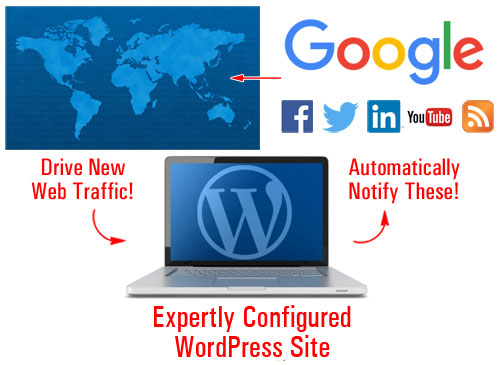
(With an expertly configured WordPress blog, all you have to do is add fresh content on a regular basis to automatically drive traffic!)
In Part 2, we focused on critical setup decisions. We helped you understand the best way to get started if you don’t have a website yet, how to set things up if you already have a website, and what to do if your existing site was built using WordPress.
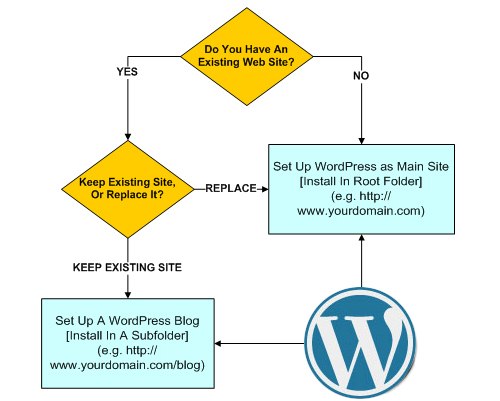
(In Part 2 we show you where to set up a WordPress site on your domain)
In this article, we will discuss the configuration phase of the traffic system. We will show you how a WordPress site should be configured in order to bring visitors automatically simply by regularly adding new content on your WordPress site.
WordPress Traffic Blueprint – Configuration Phase
Finding ways to drive more traffic to one’s website is often cited by most business owners as one of their greatest challenges online. With competition making business survival progressively tougher businesses are exploring every opportunity they can to increase their competitiveness online.
Having the ability to automatically generate traffic on demand can provide website owners with a tremendous advantage. For WordPress users, an expertly configured website allows their business to get off to a flying start from the moment their site is launched.
The Configuration Process Is The Difference
There is a significant difference between an expertly configured WordPress site and a website that has been professionally set up by an expert website developer but not necessarily configured to its fullest advantage.
Here is a simple way to explain the differences:
With a WordPress website that has been expertly configured you get a professional web presence and online business marketing automation!
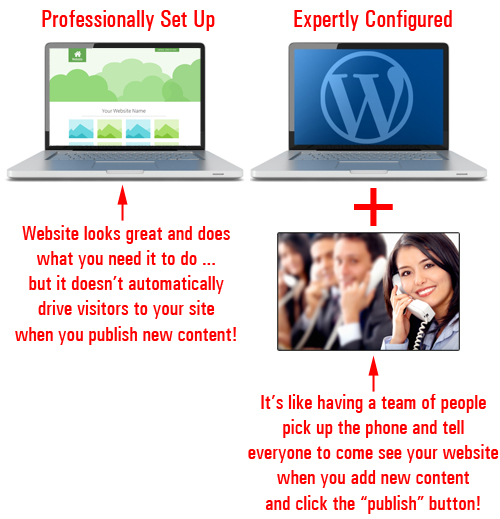
(An expertly configured site gives you a web presence with an automated online business marketing system!)
Not only does it take more labor to build and integrate an automated online business marketing system into your website, but also a special type of expertise.
To illustrate this here’s an amusing story.
Knowing Where To Tap
Things were going well in the widget manufacturing plant when everything suddenly just stopped.
As no one could figure out what happened, the floor manager decided to call in an expert to try and fix the problem.
The expert arrived shortly afterward and, without saying a word, went directly to the main control box. After staring at the schematics for no more than 2 minutes or so, the expert then produced a little hammer from his utility belt and made a very gentle tap about one cm from the left edge of the control unit.
Immediately, the whole workshop lit up and sprang to life again.
The manager was grateful and relieved as he thanked the expert, who left just as quickly as he had arrived.
A couple of days later, the manager received a request of payment for services for the amount of $5,000.
The factory manager dialed the expert, demanding to know why they were being charged such a ridiculously high fee for less than 5 minutes work and promptly requested an itemized invoice before hanging up.
The next day, a bill of payment arrived on the manager’s desk. Upon opening the envelope, this is what he saw:
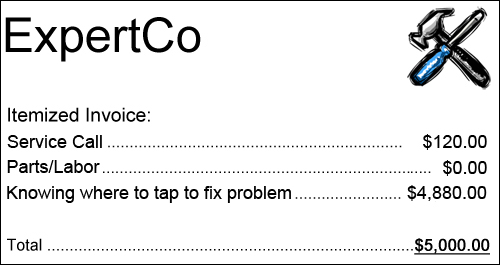
The main challenge most businesses face online is driving new traffic to their sites.
How much money did the plant stand to lose when production stopped functioning and no one on the factory floor had the expertise to get things up and running again? Did the expert not have every right to be compensated fairly for having invested years acquiring the knowledge and expertise that enabled him to immediately assess and repair a costly problem?
Similarly, if you could have your blog fully set up so all you ever had to do is publish content to it and Google, Facebook, Twitter, LinkedIn, Pinterest and dozens of other online properties would be automatically notified, how much time and money would you save?
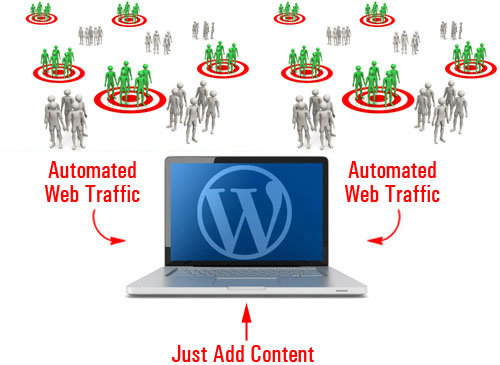
(How much better would your business be if you could automate the process of attracting new visitors to your website?)
Although many experts often make complex things look simple, it rarely is that simple or easy when you try to work things out.
Knowing how to expertly configure a WordPress site involves more than simply installing a website and configuring a few settings. It also involves knowing where to tap! In other words, knowing things such as:
- Which plugins you need to install to add certain functionalities to your site.
- Which third-party accounts you need to set up and activate to achieve certain outcomes
- Which options you need to configure in order to make sure processes will run exactly as you want, etc.
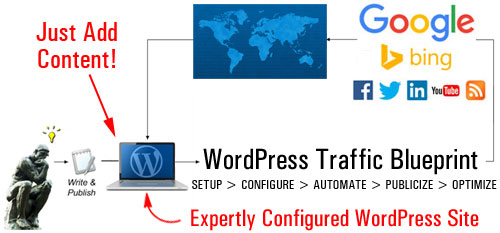
(Generating new traffic automatically with WordPress is a process that requires expertise)
Although this part of the WordPress traffic automation system may not seem so technically difficult, it can be quite involved. The reason why is because it’s not as easy as installing and configuring a solution, clicking on a button or two, or tweaking some options and settings in your dashboard area … it’s all this and much more.
The configuration phase involves the integration of different components including your server, your website, and a number of external sites …
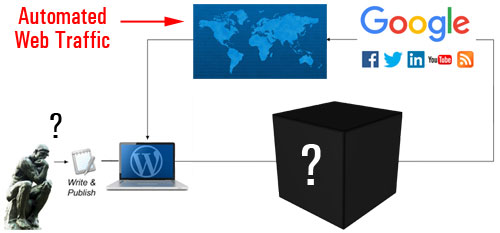
(Expertly configuring your website involves more than just configuring some WordPress settings)
If we were to create a simplified diagram of the activities involved in the configuration process, it would look something like this …
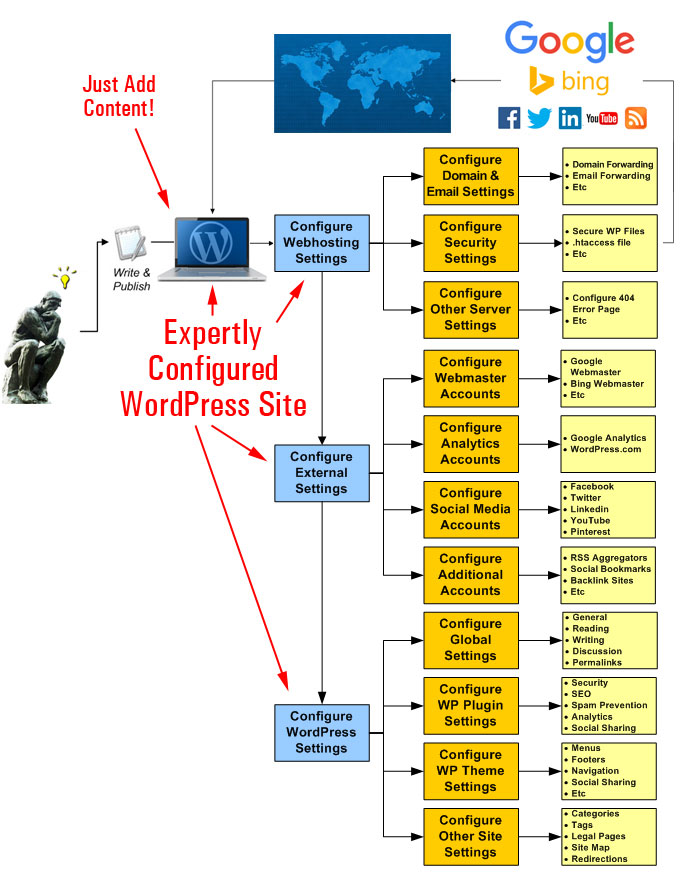
(A simplified flowchart of all the steps involved in the configuration phase)
Let’s take a look at these steps.
Web Server Configuration
We’re not talking about the process of configuring your hosting account for installation purposes. What we are talking about, is configuring settings and options in your web-hosting account that affect how you will handle all web traffic …
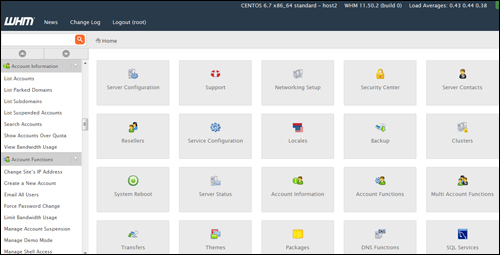
(In the configuration phase, your server settings need to be fine-tuned for handling both good and bad traffic)
Not all web traffic is positive traffic. Some of the web traffic your website will attract will be unwanted traffic like bot spam, malicious threats, bot-hacking attempts, etc.
This stage of the configuration process, therefore, is about evaluating your needs, planning for bad and good traffic and adjusting settings in your server accordingly. This can include looking at things like spam protection and threat prevention, to configuring your domain and email redirections, setting up htaccess file redirections, etc …
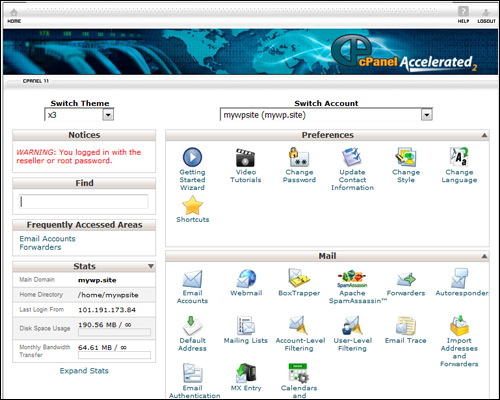
(Have you configured your control panel settings for handling things like email forwarding, page errors, etc?)
After your web server settings have been checked and configured, the next step is to configure a number of third-party sites or online services.
External Services
The idea behind adding external sites is that all content is posted to a central location (your WordPress site) and from there, it gets distributed automatically to other parts of your traffic system, or notify traffic-related web properties and services.
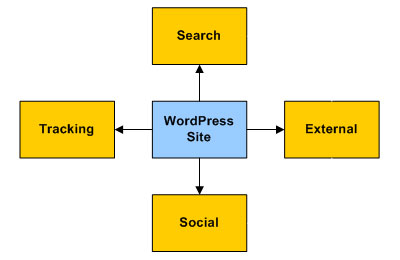
After adding these external services to your traffic network, content linked back to your site gets automatically syndicated to search, social and aggregator sites. Your content and website will be given added exposure to a new audience and new sources of traffic.
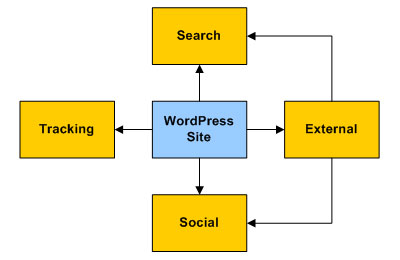
Some of the sites and services will need to be set up before configuring your WordPress site’s settings to speed up the process and some will need to be done later, during the automation phase.
For example, here are just some of the accounts you will need to have set up:
Google Search Console
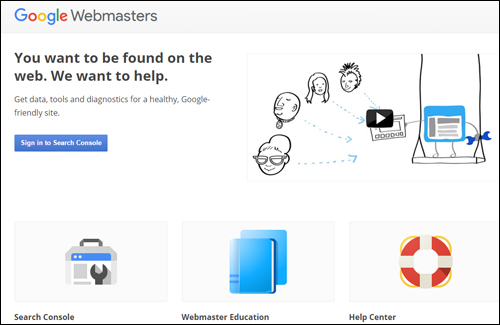
(Google Webmaster Tools)
Google Webmaster Tools lets you tell Google about your site’s pages, submit XML sitemaps for faster page indexing, and provides site owners with a range of important data, SEO tools, and reports about their website.
After setting up your account with Google Search Console, your information can be used to integrate and automate web traffic-related settings and notifications in WordPress using plugins like Yoast SEO and other applications.
Google Analytics

(Google Analytics)
Google Analytics lets you improve your website’s traffic performance, SEO, marketing efforts, and more, by tracking all user behavior, pages visited, keywords searched for, search engine referrals, etc.
Once your Google Analytics account is set up, you can add traffic tracking information to WordPress using a simple Google Analytics plugin and feed data automatically to various other applications.
Bing Data And Tools
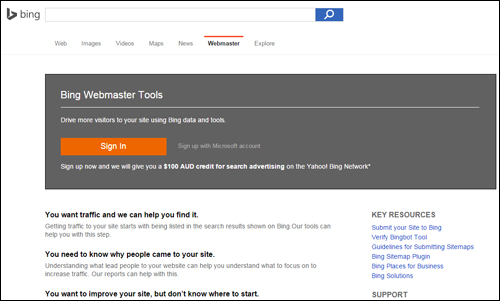
(Drive more traffic with Bing Webmaster Tools)
Bing Webmaster Tools is similar to Google Search Console. Once your account is with Bing have been set up, use this information to automate traffic-related settings and notifications in WordPress and other applications.
WordPress.com
(WordPress.com)
As discussed in Part 2, WordPress offers both a hosted (WordPress.com) and a self-hosted (WordPress.org) option. We recommended choosing the self-hosted WordPress option if you plan to build a professional online presence.
WordPress.com (the hosted option), however, provides some great features, which various WordPress plugins can access. We recommend setting up an account at WordPress.com, therefore, and we’ll show you how to integrate this into your web traffic system in Part Four of this article series.
Social Media And Social Bookmarking
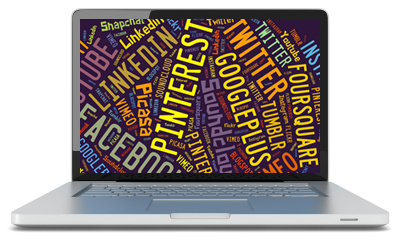
(Syndicate your content automatically to your social media pages and bring new visitors to your site)
You will need to have already set up your social accounts in order to integrate these with your traffic generation system.
Once you have set up and configured everything, you will be able to syndicate your content automatically to your social media and social bookmarking accounts and drive new visitors to your site.
Set up accounts and profile pages with all the leading social networks – Facebook, Twitter, LinkedIn, Pinterest, YouTube, etc.

There are loads of social bookmarking sites you can You can post your content to lots of social sites. You don’t need to create accounts with all of them, just select the ones that will work with your system and/or content syndication tools.
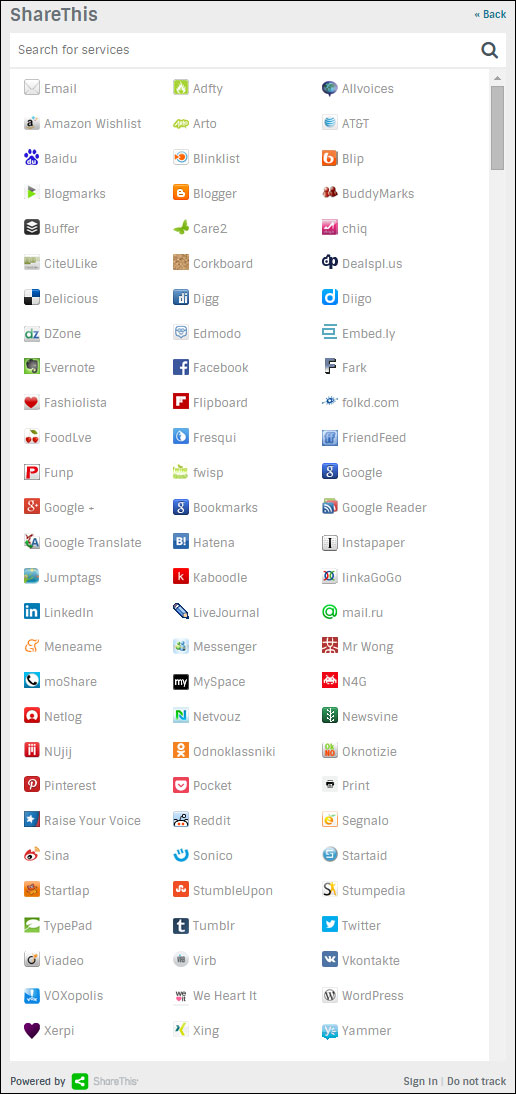
(You can post your content to loads of social bookmarking sites. Image source ShareThis.com)
Additional Solutions, RSS Aggregators, Etc.
There are a number of emerging technology platforms and RSS aggregators that can act as secondary-level traffic generation sources. Some are free or provide free levels, and some offer a range of pricing plans.
For example, here is a content aggregator site that allows you to add an RSS feed from your WordPress blog …
RebelMouse
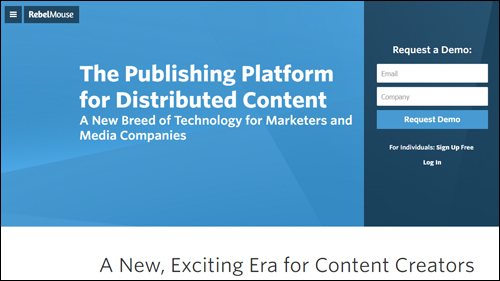
(RebelMouse)
RebelMouse is a news aggregator for your social profiles and RSS feeds. Your content displays in a Pinterest-like format and users can follow your account.
![]()
There are various solutions that can be incorporated into your own web traffic blueprint. Please contact us if you need assistance exploring some of these further, or to discuss a strategy to suit your needs.
After you have configured your web server and set up external service accounts, it’s time to configure your WordPress site.
Configuring Your WordPress Site
The first step in configuring your site for traffic is to make sure that its global settings have been set up correctly.
Let’s go over some key areas.
Global WordPress Settings
By default, WordPress includes a Settings section that allows you to modify your site’s global settings …
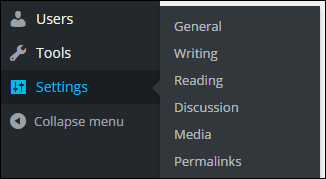
(WordPress settings section)
General Settings
Fields like Site Title and Tagline can influence your site’s SEO, search results, etc …
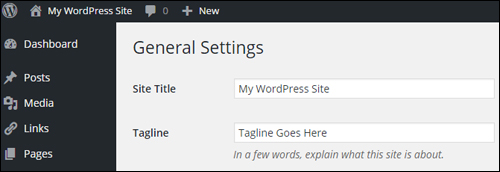
(Settings Menu – General Settings Screen)
Writing Settings
The Writing Settings section contains an important and frequently overlooked built-in traffic notification system …
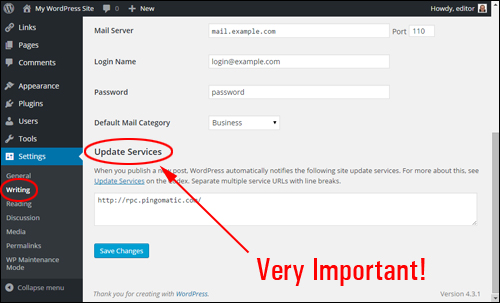
(Settings Menu – Writing Settings Screen)
As stated below the Update Services section,
When you publish a new post, WordPress automatically notifies the following site update services …
Unless you or your webmaster have intentionally configured your settings to prevent search engines from indexing your site – see next section, then your site will automatically notify the list of update services entered into the Update Services text area
With an ‘out of the box’ WordPress installation, this section includes only one entry …
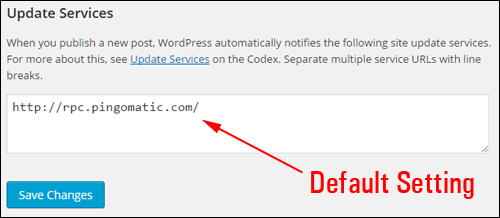
(Update Services – A Powerful Traffic Feature)
WordPress lets you notify dozens of update services automatically …
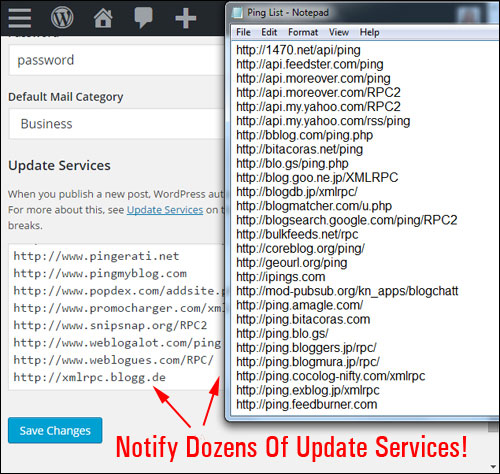
(WordPress lets you notify dozens of update services automatically!)
![]()
Download A Comprehensive List Of Ping Services For Your WordPress Site!
Click the link below to download a comprehensive list of reliable and authoritative ping services for your WordPress site or blog:
Download A List Of Ping Services For Your WordPress Site
***
Note: If you need help setting up the list of ping services on your site, we recommend using a professional web services provider. You can find professional WordPress service providers in our WordPress Services Directory.
Reading
This section affects how your content gets seen by visitors when they visit your home page and blog pages.
The syndication settings on this page can have an influence traffic. For example, choosing to display the full text vs summaries of your post, affects how your content shows up in RSS feeds and RSS email campaigns, and could impact someone’s decision to explore your content further, and whether or not they will visit your blog to get the rest of the content from a partial feed, or read the content in full without the need to click through to your site.
The most important setting in this section as far as traffic is concerned is whether the Search Engine Visibility checkbox is enabled or not.
Generally, you would want search engines to visit your site. Leaving the box unchecked enables WordPress to ping all the update services you have listed in the Update Services section when a new post is published (see Writing Settings above). Unless there is a specific reason to discourage search engines from visiting your site, make sure this box is left unticked …
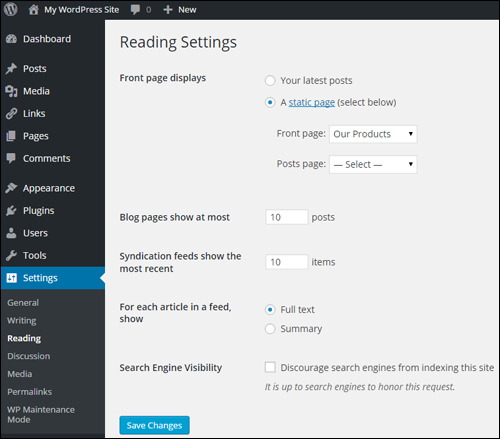
(Global Settings – Reading Settings)
Discussion Settings
Although discussion settings are mostly concerned with how users engage with content on your site, you have the option to allow notifications to sites linked to from your articles, and to allow link notifications from other blogs (pingbacks and trackbacks). This can work for you, but it can also drive bad traffic in the form of SPAM comments …
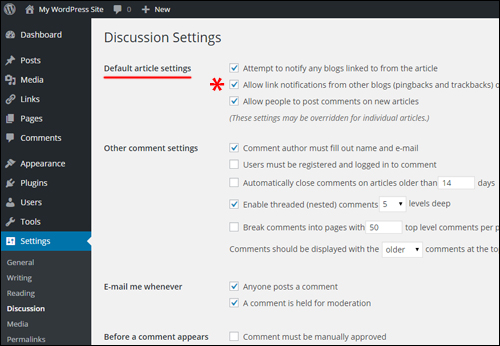
(Settings Menu – Discussion Settings Screen)
Permalinks
Permalinks enable WordPress to publish posts with SEO-friendly URLs …
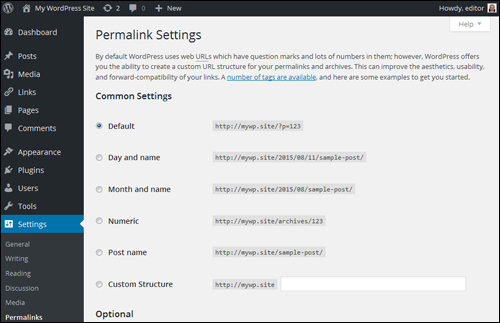
(Global Settings – Permalinks)
Here are some of the options for configuring your site’s search-friendly URLS …
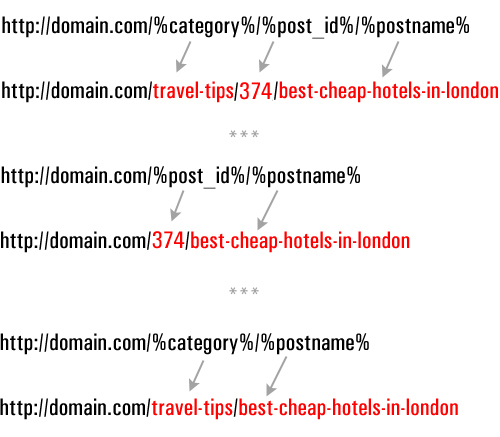
(Configuring permalinks)
If you need help setting up permalinks in WordPress, refer to this step-by-step tutorial: Using Permalinks To Improve Your WordPress SEO
Configuring WordPress Plugin Settings For Traffic Generation
The WordPress developer community makes available thousands of plugins that can add almost every kind of functionality imaginable to your site, including many plugins that improve traffic generation.
Let’s look at examples of plugin categories and plugins that can help to increase traffic
Blog Defender Security Plugin
Once again, it’s important to configure your website for handling both good traffic and bad traffic. Regardless of the type of business you run or plan to run online and how small you think your web presence is, you simply cannot afford to ignore the importance of website security.
 (WordPress Security Plugins help prevent bad traffic from causing your website harm)
(WordPress Security Plugins help prevent bad traffic from causing your website harm)
Security plugins like Blog Defender help to make your website invisible to bots and hackers.
Go here to learn more:
WordPress SEO Plugins – Yoast SEO
SEO plugins help drive traffic by improving the search engine friendliness of your website …

(WordPress SEO Plugin – Yoast SEO)
A plugin like Yoast SEO (previously called WordPress SEO by Yoast) can improve your site’s SEO. When properly configured, the Yoast SEO plugin not only makes your website easier for search engines like Google and Bing to find and index, it also lets you specify how to display your content in Google’s search results and social media sites Facebook, Twitter, and GooglePlus.
Social Plugins
Allowing your visitors to share your content online can help to increase traffic to your site, especially if you provide great content that adds real value to readers.

(WordPress users can easily add social sharing buttons to their website with free or inexpensive plugins)
You can add social sharing features to your website easily with free or inexpensive plugins.
Many social share plugins let you choose which sites your content can be shared to, embed social buttons into your content, set up default post messages, display/hide share counters (e.g. number of likes), etc. Some social sharing plugins even allow you to protect content or downloads which visitors can unlock by linking or tweeting your page.
Themes
As well as configuring various plugins, many WordPress themes also include features that help grow your traffic.
For example, as well as options and settings for configuring the layout and design of your website, some themes also include built-in features that let you improve search optimization and site linking structure for better indexing, add tracking snippets, social sharing buttons, etc …
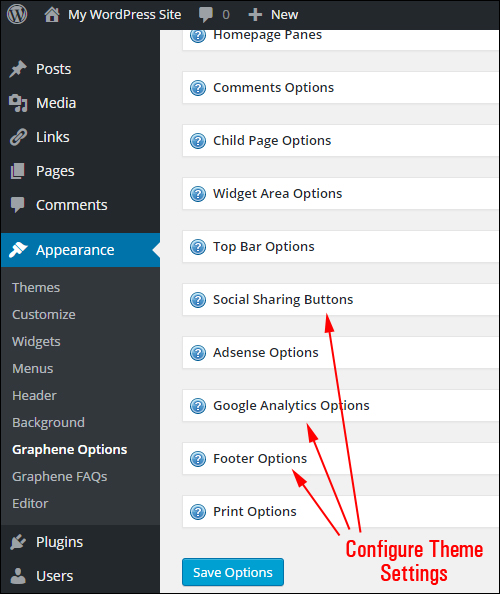
(Many WordPress themes like Graphene (a highly customizable free theme) can be configured for improved traffic results)
With a number of quality themes, adding social sharing buttons to your site is as easy as clicking a button …
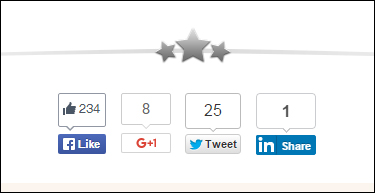
(Many WordPress themes provide users with built-in social sharing features that can be easily enabled on with the click of a button)
Other Areas To Configure
Last (but by no means least) in the web traffic configuration process, are the components that need to be configured outside of the global settings.
This includes the following:
Legal Pages
Once again, when preparing your site for an increase in traffic numbers, it’s important to plan not only how to handle bad and good traffic but also for all the things that can go wrong as more and more people start finding and visiting your website.
If you engage in any form of commercial activity online (or are planning to), it’s important that your site remains compliant with legal requirements of government agencies that regulate business practices online.
If you need help adding compliance pages to WordPress, go here:
Post Categories & Tags
Post tags and categories help improve traffic by allowing search engines to better index your website.
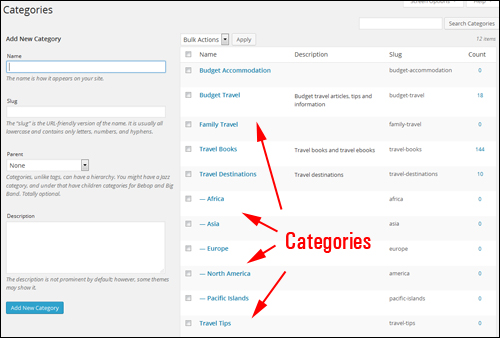
(WordPress post categories help improve traffic by improving your site’s search optimization.)
As we strongly recommend in this article, your website’s post tags and categories should be discussed and set up earlier on, during the Website Planning Phase.
In the configuration phase, you will want to review and make sure that the post tags and categories that have been set up.
Add A Site Map To Your WordPress Site
A visitor site map that lists all of your posts and pages is not only a useful navigation tool for users, it can also help external sites discover more of your online content …
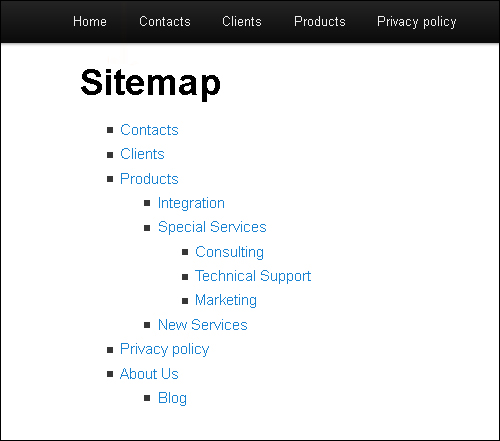
(A site map is not just great for visitors, but for web traffic too!)
![]()
An HTML site map and an XML sitemap are different things. An HTML site map is a web page that links to all other content on your site, while an XML sitemap is mostly filled with code that only search engine bots can read. Although search engines like Google can index your site just using an XML sitemap (which a plugin like Yoast SEO can provide – see earlier section), making it easier for visitors to find more pages on your site can result in increased traffic.
404 Page – A Source Of Lost Traffic Opportunities!
When visitors searching online for your website enter the wrong URL or click on a dead link, they are greeted with a 404 page …
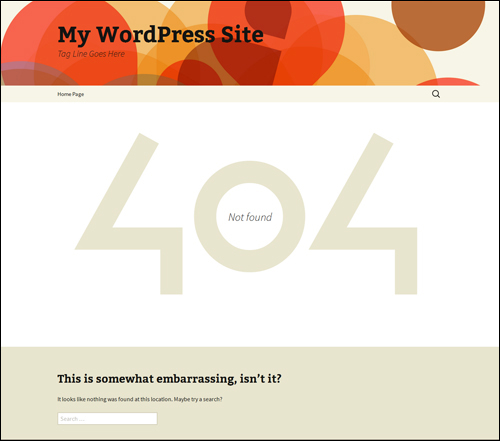
(A WordPress 404 Not Found page)
Configuring your 404 Error Page allows you to recover traffic that may otherwise be lost. …

(Configuring your 404 Error Page allows you to recover web traffic that may otherwise be lost.)
![]()
Although a 404 page can be set up on your server, there are plugins for WordPress that let you easily configure your 404 page from your WordPress admin area.
WordPress Traffic Automation Blueprint: Configuration Process – Summary
Once you have your website or blog fully set up and expertly configured, all you then need to do to generate web traffic is publish great content regularly.
The process of expertly configuring a WordPress site, however, can be quite involved and requires the configuration and integration of different components and web properties …
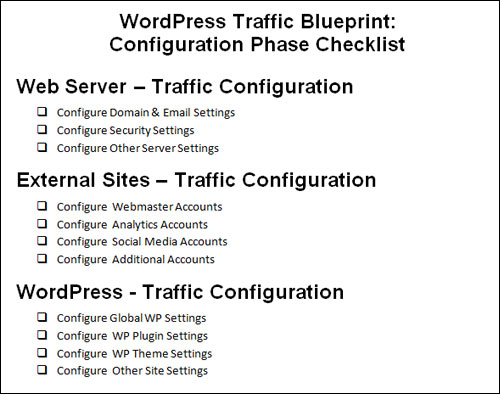
(WordPress Traffic Blueprint – Configuration Phase Checklist)
![]()
The skills and knowledge required to perform this stage of the traffic automation process typically takes some web professionals a long time to acquire.
Once you have configured your WordPress site, the next step is to automate as much of the process as you can. This step is explained in the next article in the WordPress Traffic Automation Blueprint series.
This is the end of Section Three
To read the rest of this article, click on the link below:
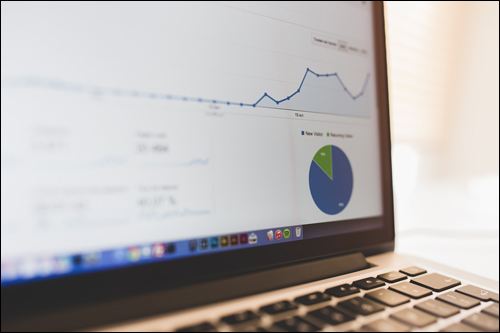
![]()
This article is part of an tutorial series aimed at helping you learn how to grow your business online inexpensively with a WordPress-powered website and proven web marketing strategies.
Get Notified When New Tutorials Get Published – Subscribe To WPCompendium.org!
***
"If you're new to WordPress, this can stand on its own as a training course and will stay with you as you progress from beginner to advanced and even guru status." - Bruce (Columbus, Ohio)
***

